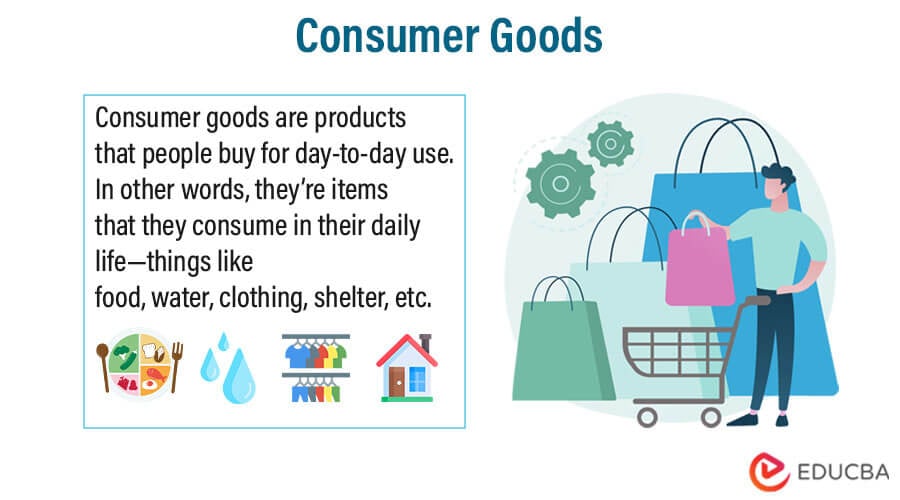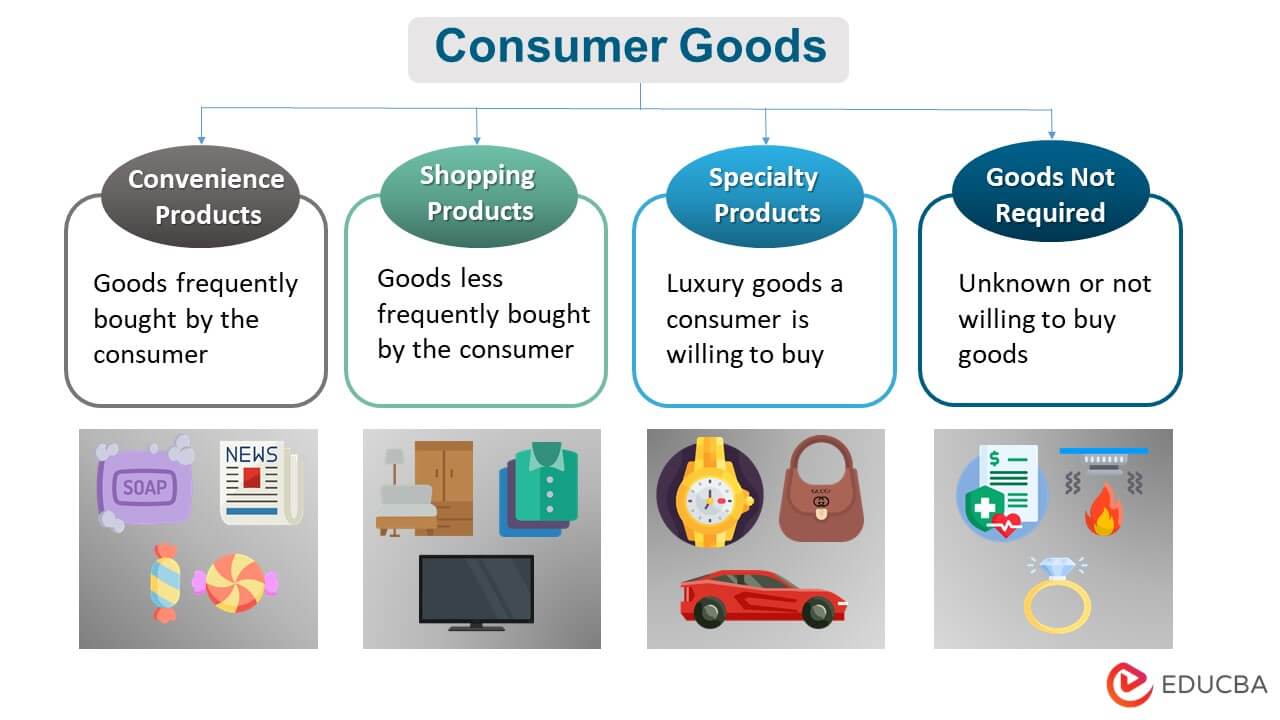Definition
Consumer goods are products that people buy for day-to-day use. In other words, they are items that people consume daily. It includes things like food, water, clothing, shelter, etc. The term is often used to refer to a category of products that includes food, clothing, furniture, and other items.
They can be classified into two categories: durable and nondurable. Durable consumer goods such as furniture, cars, and appliances last longer than three years. Nondurable consumer goods are those that do not last long enough to be considered durable, such as food and clothing.
Key Highlights
- Consumer goods are all the things that consumers buy for their own consumption. It includes both durable and non-durable goods. Durable goods include items such as cars, furniture, and appliances that have long-term usability. Non-durable goods, conversely, encompass consumable items like food, clothes, and cosmetics that can be quickly used or worn out.
- In economics, consumption refers to the economic process by which people’s needs or desires are met, and it is thus the final stage of the production chain
- A consumer good is an item that people purchase and do not need to undergo any productive transformation because they will not use it to produce other items.
- Any economy has a variety of goods that vary depending on the purpose they serve. The assets used to produce other goods are known as capital goods. Intermediate goods are vital in creating the final product, as they are utilized as inputs, while consumer goods are directly sold to end users.
What Are Consumer Goods?
- Consumer goods, as the name implies, are products that are typically at the end of the production chain, that is, goods that the consumer purchases to make subsequent or direct use of the good
- A consumer good is the final product of a manufacturing process. As a result, it directly meets people’s needs
- Consumer goods are products that people buy for day-to-day use. In other words, they’re items they consume daily—things like food, water, clothing, shelter, etc. These are often (but not always) essentials—that is to say, if you don’t have these things, you may also find yourself lacking in other areas of life.
Characteristics of Consumer Goods
- A consumer good is any item or product that an individual can buy
- External factors such as marketing, convenience, brand name, and other sociological factors actively influence the value of these goods and their use
- An important characteristic of a consumer good is that it must be purchased through some sort of market exchange process
- This means that a consumer good cannot be produced directly by its user
- For example, if you grow your own food, then you are producing your own food; however, if you purchase apples from a grocery store (or even from another person), then you are buying apples rather than producing them yourself
- This does not mean that all consumer goods are manufactured items; many services fall into this category as well
- For instance, most people would consider medical care to be a service rather than a physical good
- However, since consumers pay for medical care with money instead of bartering or exchanging labor, they still purchase something created specifically to meet their needs. In addition to being purchased through markets, consumer goods tend to have relatively low production costs compared with capital goods and intermediate goods.
How Does it Work?
1. Consumer goods are the products that people buy and use daily. These products include clothes, food, cars, and televisions. They are often considered part of the economy’s consumer spending. The way they work is through production, distribution, and consumption.
2. There are four steps in this process:
- Producers create goods
- Distributors take them to marketplaces
- Consumers purchase them and make use of them
- Then, after some time, they discard what they don’t need.
3. First, there must be an idea for a new good or service
4. Someone has to come up with an idea for something that will satisfy people’s needs or wants
5. After someone decides on a new product or service, it goes into production
6. If it takes months or years for it to go from idea to actual product, it will have gone through stages like research and development and testing before release onto the market.
Types of Consumer Goods
A team has developed a highly effective system that categorizes consumer goods based on people’s purchasing patterns. It makes sense to classify products based on their behavior since the marketing process aims to satisfy the needs of final consumers.
1. Convenience goods: can be divided into 4 categories using this method:
Emergency supplies, everyday consumer goods, and impulse buys are all categories of convenience goods.
- Current consumption items are those that are frequently used in each home. They are typically bought frequently and automatically, without giving them more thought than is necessary at first
- Goods bought by impulse are those that were not planned. When making this kind of purchase, customers frequently don’t compare the item to others’ offerings and instead buy it right away, giving in to their immediate desire
- Emergency supplies: They are only bought when a pressing need arises. The price is not particularly important because the customer needs them right away.
2. Comparison goods are products that, in the eyes of the customer, are worth the time and effort needed for a thorough analysis and comparison with rivals. Depending on the kind of product that customers are looking for, these products can be divided into two categories:
- Homogeneous items: Homogeneous items are products that the consumer perceives as essentially similar and wants to purchase at the lowest price. The consumer considers these products to have comparable quality but different enough pricing to enable convenient comparisons.
- Heterogeneous items: Items that the customer perceives as heterogeneous prompt him to check their quality, durability, convenience, and style.
3. Specialties are products with distinctive qualities and/or high-prestige brands that a significant group of buyers is willing to pursue with extra care. A branded product that successfully attracts a sizable clientele may ascend to the hierarchy in its field.
Because prospective customers are willing to insist on the item, the demand for specialties will be relatively inelastic, at least on a reasonable price scale.
4. Goods not required: The term “goods not required” refers to items that people ignore or, despite being aware of their existence, rarely consider purchasing even though they eventually do so.
Companies must undertake significant marketing efforts, including advertising and personal selling, to promote unneeded products or those not frequently sought after.
Examples of Consumer Goods
Here are some examples of consumer goods:
- Everyday items: Households regularly purchase and use everyday items, which include food, medications, and other essentials. People buy items like rice, butter, biscuits, toothpaste, and analgesics as part of their everyday shopping routine.
- Impulse-acquired: Supermarkets display magazines, candies, and chocolates next to checkout counters, tempting customers into buying them on a whim.
- Emergency goods: An umbrella is a necessity during a storm
- Homogeneous items: Homogeneous Items include buying bread, toiletries, soft drinks, or a comb
- Heterogeneous items: When purchasing custom clothing, furniture, or tableware, the characteristics of the product are typically more significant to the consumer than the price
- Specialties: Examples are a Rolex watch or a Mercedes-Benz automobile
- Goods not required:
Benefits of Consumer Goods
- Accessible to all: We can emphasize the rise in accessibility when purchasing a good or a product because of the variety of available products. Currently, you can order it online and have it delivered right to your front door
- Quantity: Society and businesses can easily sell and provide the quantity you need or want.
- Quality: We can select the best product or service after considering the variations in their various offerings. This relates to the values of those who have been able to purchase particular goods.
Conclusion
The consumer goods industry is a very competitive one. It is not easy to stay on top of the game in this industry. Consumers always demand more for less, and companies must constantly keep up with their demands by innovating and creating new products.
As a result, the consumer goods industry has been growing rapidly over the last few decades due to all these innovations and new products that have been created. The growth in this industry has become even faster as more people enter the global market, which means more consumers want these products.
Frequently Asked Questions(FAQs)
Q1. What are consumer goods?
Answer: Consumer goods constitute the ultimate products of an economy’s production chain, directly fulfilling people’s needs instead of serving as means for producing other goods and services.
Q2. What are Fast Moving Consumer Goods?
Answer: Fast-moving consumer goods, or FMCGs, are products typically low in cost and volume. Impulse buyers, or people who make purchases on a whim, typically purchase them.
Q3. What is the difference between Consumer Goods and Capital Goods?
Answer: Consumer goods and capital goods represent two distinct concepts often mistakenly used interchangeably. Many people confuse the terms consumer goods and capital goods. The difference between consumer goods and capital goods is that consumer goods are products you buy to consume, while capital goods are products that businesses use in production. This means that consumer items such as food, clothes, electronics, furniture, etc., are all considered consumer goods.
Q4. What are some examples of Consumer Goods?
Answer: Consumer goods are a general term for products the end-consumer uses. They can be bought at a grocery store, convenience store, or online. Examples include food, clothing, and electronics.
Q5. What impact has E-Commerce had on Consumer Goods Demand?
Answer: In the last decade, E-Commerce has significantly impacted consumer goods demand. The internet has become popular to buy new and used items, including clothes, furniture, and even cars.
Many people who would not have previously considered buying these items online are now doing so due to the convenience and savings offered by E-Commerce. This is one reason why many traditional retailers have struggled to remain profitable recently.
Recommended Articles
This was a guide to Consumer Goods. To learn more, please read the following articles:



